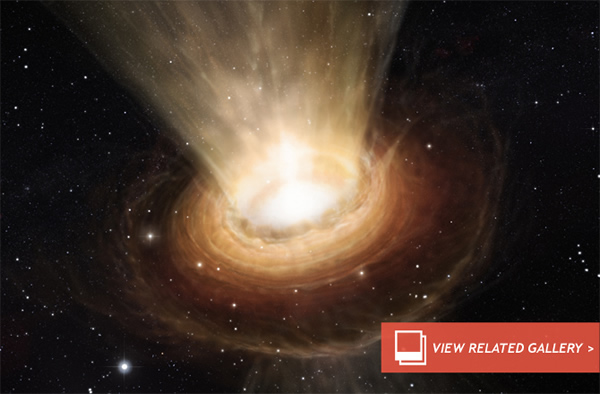How Do Supermassive Black Holes Get So Fat?
Gravitational waves are the elusive ripples in spacetime that are theorized to pervade the entire Universe, generated by violent events, chronicling the evolution of some of the most massive objects in the Cosmos. Now, by using a clever technique to measure the observed variations in pulsar spin rates, astronomers may be getting close to not only observing the presence of these waves, but also understanding why some of the biggest black holes are so fat.
Supermassive black holes are known to lurk in the centers of the majority of galaxies. These are truly massive structures, weighing in at millions to billions of solar masses. The supermassive black hole in the center of the Milky Way, for example, has a mass of approximately 4 million suns; the most massive black hole observed to date can be found 308 million light-years away in the supergiant elliptical galaxy NGC 4889 (Caldwell 35) — it is estimated to be 21 billion solar masses.
Although we know there gargantuan objects exist, astronomers are having a hard time understanding how they became so big.
So, in an effort to unlock this black hole evolution conundrum, astronomers using data from the CSIRO Parkes radio telescope in eastern Australia are observing the fast-spinning husks of burnt-out stars to reveal the history of supermassive black hole growth.
Neutron stars are formed after the core collapse of massive stars as they go supernova. Some of these exotic objects manifest themselves as pulsars — powerful beams of energy blast from their poles and, should the alignment be correct, these emissions are observed as radio flashes in the dark, like cosmic lighthouses. These pulses are very precise, so should astronomers detect slight variations in the pulse times, something has changed in the environment separating us from the pulsar.
Gravitational waves, as predicted by Einstein, have yet to be directly observed, although physicists are going through great pains to detect them. Astronomers hope to measure the tiny pulse variations in the timings of 20 pulsars to put some physical constraints on gravitational waves generated via black hole mergers. This is an epic quest; they’re basically looking for the echoes of supermassive black hole collisions that reverberate throughout the Universe as a graviational wave “background.”
“This is the first time we’ve been able to use information about gravitational waves to study another aspect of the Universe — the growth of massive black holes,” said Ramesh Bhat, of the Curtin University node of the International Center for Radio Astronomy Research (ICRAR), in a news release.
“Black holes are almost impossible to observe directly, but armed with this powerful new tool we’re in for some exciting times in astronomy. One model for how black holes grow has already been discounted, and now we’re going to start looking at the others.”
The big question about the biggest black holes is whether they packed on the pounds by violently merging with other black holes, or whether some other growth process is at work. If the former is true, there should be a clue hidden in the nature of gravitational waves.
“When the black holes get close to meeting they emit gravitational waves at just the frequency that we should be able to detect,” said Bhat, who co-authored a study that has been published in the journal Science with postdoctorate researcher Ryan Shannon and PhD postgraduate Vikram Ravi.
When gravitational waves pass through spacetime they are theorized to slightly shrink or expand the distance between two objects. In the case of timing the radio pulses from pulsars, the presence of gravitational waves should slightly affect the detection times of the pulses as the radio waves will have traveled through an ocean of rippling gravitational waves. After careful analysis of the received pulse timing variations, the cacophony of gravitational waves generated by colliding black holes should be detected.
“The strength of the gravitational wave background depends on how often supermassive black holes spiral together and merge, how massive they are, and how far away they are. So if the background is low, that puts a limit on one or more of those factors,” said Bhat.
Using 20 years of data from the Parkes Pulsar Timing Array (PPTA), the researchers have drawn an early conclusion that supermassive black holes didn’t solely gain mass through mergers. While the data isn’t enough to detect gravitational waves outright, they have begun to put valuable limits on gravitational wave frequency and their possible source.
Image: Artist’s impression of the surroundings of the supermassive black hole in NGC 3783. Credit: ESO(Oct 21, 2013 04:33 PM ET // by Ian O'Neill)












